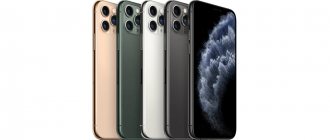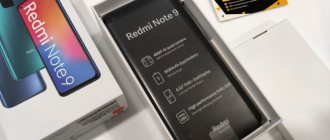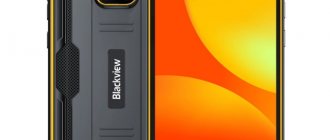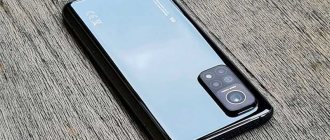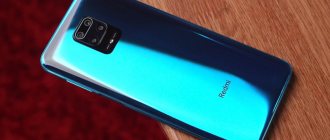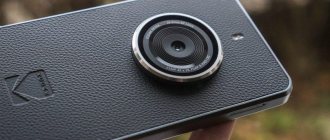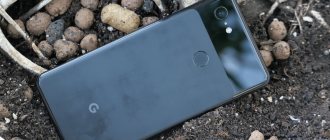We'll tell you what you'll like about the new model, and what will upset and surprise you about it - in this review of the Redmi 9 smartphone
Well, this time it looks like we may be getting the perfect budget smartphone that has more than we expected. Redmi 9 has both a high-resolution screen and relatively powerful hardware, a capacious battery, many cameras, as well as a modern Type-C connector and an NFC module. At first glance, there are no compromises, but with some reservations. We’ll talk about all this without hiding in this Redmi 9 review.
Bigger screen, clearer picture
The phone has a screen with a cutout in the center for the front camera. One could complain that this is no longer a fashion trend, but the phone is inexpensive and this is forgivable. The quality of the IPS display is good: it has a normal, albeit not the largest, brightness reserve, slightly “blue,” but you can manually correct the colors if desired.
The inexpensive Redmi 9 features a high-resolution display: if the Redmi 8 had an HD+ screen, now it has Full HD+. Taking into account the diagonal increased to 6.53 inches, this is a sensible step. The glass is rounded at the edges, just like in more expensive phones.
An interesting fact: Redmi 8 had Gorilla Glass 5 protection; in my review of the smartphone, I complained that the glass of this generation quickly became covered with small scratches. Now Redmi 9 has old-generation Gorilla Glass 3, which may be stronger. Just in case, a factory protective film is pasted on the screen, a nice bonus. The screen frames are decent and large, but I won’t blame a budget phone for this, the price justifies everything. It’s just a pity that Redmi 9 no longer has an indicator light.
General impression of Redmi 9
The device turned out to be at a decent level: it copes well with games, although not always at maximum settings. Its performance is enough to perform everyday tasks, so it definitely won’t slow down when surfing the Internet.
Despite the low resolution of the main photo module, the device is capable of producing high-quality panoramic and macro photos. It's nice to have a depth sensor, which makes portraits more interesting. The obvious advantages include a capacious rechargeable battery, the resource of which is enough for at least 2 days of use without recharging.
Plastic essence
The body is made of plastic, and it is a matte rather than glossy material. There are no traces or fingerprints after contact, after the very elegant, but equally easily soiled Redmi 8, it’s just a song. In addition, the smartphone has a beautiful gradient pattern: in my case, it is a transition from blue to purple.
The body is corrugated, the notch is fine and not rough, the surface is slightly rough and pleasant. Again, due to this design, Redmi 9 turned out to be not slippery at all. I also liked the small decorative element in the form of a circle; it highlights the camera area, and at the same time reminds me of the Redmi K30 with the same design element.
Size and comfort
I'm not a fan of tiny phones, but there aren't enough inexpensive smartphones with relatively small screens. After all, even “regular” Redmi are no longer different in size from the larger Redmi Note. I took Redmi Note 8 Pro out of storage, so it’s even a little smaller than Redmi 9:
Here's another photo for comparison next to the Redmi 4X; it was once a standard representative of the Redmi line, neither big nor small, ordinary, but now it's just tiny:
Naturally, the issue of ease of use of Redmi 9 depends solely on how much you like devices of this format. If you don’t have anything against a large screen, you’ll quickly adapt. But if you're looking for a compact replacement for your old small phone, then I have bad news for you.
If you put the Redmi 9 in a complete case to protect the case, it will increase in size, I would look for something lighter and thinner instead of the standard one. In addition, he still has a stupid plug covering the USB port.
Of the obvious ergonomic miscalculations, I would like to highlight the location of the fingerprint scanner. Like Redmi 8, it is located on a single platform with three camera modules. Therefore, most often you accidentally hit one of the lenses when you try to blindly press the scanner. Alternatively, you can set up face unlock: the method is not the most reliable, but it is faster and more convenient. However, I have no questions about the sensitivity of the scanner; it works fine.
Sensors and technologies
Xiaomi Redmi 9 is equipped with all the necessary sensors. And almost all of them work as correctly as possible. Problems are observed only with the light sensor due to the MIUI shell. When the brightness of the surrounding light decreases insignificantly, the system turns the brightness settings to minimum. You have to edit them manually. However, in subsequent MIUI updates the developers may fix this bug.
A high-speed fingerprint scanner is located on the rear panel of the device. This scanner location is standard for many budget devices. The list of sensors does not include only a Hall sensor, but Xiaomi does not install it in smartphones of this price category. But there is a facial recognition function, which uses the front camera.
| Fingerprint's scanner | Yes, back panel |
| Face recognition | Yes |
| Proximity sensor | Yes |
| Light sensor | Yes |
| Hall Sensor | No |
| Accelerometer | Yes |
| Compass | Yes |
| Gyroscope | Yes |
New Xiaomi:
- Redmi K50 Gaming
February 18, 2022
- Redmi Note 11S
January 26, 2022
- Redmi Note 11 Pro 5G
January 26, 2022
- Xiaomi 11i
January 7, 2022
- Xiaomi 12
December 28, 2021
Photo quality
The inexpensive smartphone was upgraded throughout the entire program; Redmi 9 received four modules at once: main, ultra-wide-angle, macro and portrait for measuring the depth of the frame and processing the background.
This is what the macro looks like:
Now take pictures with the ultra-wide-angle camera. It has no autofocus and low detail:
A few photos for the main one:
The most ordinary camera that does not like shooting in low light conditions. In this case, a flash can come to the rescue, but there is no separate night mode.
Selfie on the front camera with portrait mode:
The verdict is this: Redmi 9 has a lot of modules, there is something to “play with” if you suddenly get bored. But miracles don’t happen, and an inexpensive phone produces images of appropriate quality.
Camera
Redmi Note 9 has five cameras:
- The main wide-angle is 48 MP. Redmi Note 7 received a similar one a year and a half ago. Most photos with this camera will be taken in 12 megapixel mode, when four pixels are combined into one large one. This is a fairly large 1/2.0-inch matrix with each pixel measuring 0.8 µm. Equivalent focal length - 26 mm, aperture - f/1.8;
- The ultra-wide-angle camera takes pictures with a resolution of 8 megapixels. The matrix size is 1/4.0 inch. The size of each pixel is 1.12 µm. The viewing angle is 118°, and the lens aperture is f/2.2;
- The front camera takes pictures with a resolution of 13 megapixels. This is a relatively large matrix with a diagonal of 1/3.1 inches. Moreover, the size of each pixel is identical to the ultra-wide – 1.12 µm. The equivalent focal length is 29mm and the aperture is f/2.3.
The remaining two cameras are macro and depth sensor. Both have a resolution of 2 megapixels.
Let's start with something simple - take a picture in good lighting conditions with the main camera.
For my taste, the picture came out overexposed, although the conditions were very good: the car was parked in the shade of trees, and I was there too. However, the yellow color of the Camaro turned out to be not as rich as it was in reality.
And this is already 48 megapixel mode. It is needed to obtain information. For example, you do not see the number of a bus passing by. Let's crop the photo to 100%:
Khobana: bus number 230!
The portrait was taken in more difficult conditions: against the light. That is, the camera sees something very bright. You need to achieve a balance where the shadows don’t fade into black and the photo doesn’t look overexposed.
Good detail, the camera clearly understood what (or rather, who) to focus on. The photo looks alive even despite the overexposed sky. It is also worth praising the way the smartphone blurred the background: the gradation of blur depending on the distance of the object is very good.
Photo taken with the front camera. There are good details here, but the camera, even with the beauty feature turned off, tried to even out the skin tone. If we fight for objectivity, then where are my black eyes from unsuccessful attempts to go to bed early? I don’t see them here, but they are there! On the other hand, it’s better to post just such a photo on Insta, and not something that will make people want to put you to sleep by injecting a large dose of sleeping pills.
And this is a macro camera. The resolution of the images is 1600 × 1200 pixels, that is, 2 megapixels. The camera focused on the flower for a very long time, but could not do it.
You can find the original photos on Google Drive.
Performance
Previously, I had not come across devices with a MediaTek Helio G80 processor, so it was interesting to see how things stood with performance. Compared to the old Redmi 8, again, the progress is obvious, the phone has increased in speed. Although at times there are dulling out of the blue, I attribute this to crude software.
Everything is fine with games, if you don’t have high expectations from a smartphone, then it won’t disappoint. You can play PUBG on medium graphics settings, but there may be stuttering and frame rate drops. Therefore, on such a non-gaming smartphone, it is still better to set low parameters in demanding toys.
I received a Redmi 9 with 3/32 GB of memory for testing; there is also a more interesting version with 4/64 GB. I don’t recommend saving: the memory fills up quickly and it’s better to fork out for a more powerful option. Because on a new smartphone, out of 32 GB, about 14 GB is available, and this is very little.
Iron
The main difference from the Pro version is the processor. Instead of the Snapdragon 720G, there is a MediaTek Helio G85. And this is not the best news for gamers. The benchmark and throttling test confirm this point of view:
Buyers have two versions to choose from: 3/64 and 4/128 GB. I have a younger one for review. At the same time, the smartphone has the ability to work with two SIM cards, which do not interfere with microSD.
Redmi Note 9. Photo: Ilya Kichaev / Wylsacom Media
In my opinion, three gigabytes is not enough for a smartphone. In this version, my smartphone unloaded applications from memory, and running applications. I haven’t encountered this on Xiaomi for a long time, so I’m blaming the RAM.
Like the Pro version, it has a battery with a nominal capacity of 5020 mAh. But the charging is weaker - in the box you will find a power supply with a power of not 30, but 22.5 W. But this, in principle, is quite enough.
The battery and processor perform well together: in some ways they are superior to the Redmi Note 9 Pro, in others they are inferior to it. I assume the battery charge will last for two daylight hours. My opinion is supported by the fact that Redmi Note 9 is not a gaming solution. The smartphone can cope with the user’s daily tasks without any problems - be it correspondence in instant messengers, negotiations by mail, sometimes YouTube and browsing.
Redmi Note 9. Photo: Alexey Bulgakov / Wylsacom Media
There is also reverse charging: you connect the cable to the device you want to charge from Redmi Note 9, and the smartphone will deliver energy with a power of 9 W. Cooler than the stock 5W chargers you find in the box with most iPhone models.
Don't forget that your smartphone has NFC. And on the street of Xiaomi owners this is still considered a cause for celebration!
Connection
At the top end there is an infrared port, with its help you can control household appliances, turning your phone into a remote control. Traditionally, the smartphone has two slots for SIM cards, and there is also a separate slot for a memory card. The 3.5 mm jack for wired headphones has been preserved; they are not included in the package, but this is already a massive trend.
But modern USB Type-C is used for charging, and in addition, the phone has NFC - an important difference between the global version of Redmi 9 and the Chinese one.
Appearance Features
The design uses only three colors: dark gray, orange and blue. The back cover is made of textured plastic, which is highly resistant to slipping. A certain disadvantage of this texture is that the surface is more susceptible to contamination. But there is also a significant plus - traces from hand touches on it will not be noticeable at all.
A fingerprint scanner is located in the central part of the back cover. It was decided to send the main camera modules to the left side of the rear surface. A new trend can be seen in their design: a square block with rounded edges. Along with the photomodules, it also houses a single LED flash.
The Redmi 9C does not have an infrared module, so you won’t be able to use the phone as a remote control.
Autonomy
The smartphone is equipped with a 10 W power supply; it also supports fast charging, but for this you need to fork out for the purchase of a separate accessory. From the supplied unit it is fully charged in just over three hours. I tried the 18-watt power supply that comes with the Google Pixel, and it got exactly two and a half hours.
In terms of energy consumption, Redmi 9 does not show miracles of autonomy, yet after a couple of years I got used to the fact that phones of this level work for a couple of days. With very active use, one day of work is obtained, but this is practically without letting go of the smartphone.
Software
Out of the box, Oppo A15 and Redmi 9C run the Android 10 operating system. The proprietary Xiaomi MIUI interface itself is very responsive, fast, and without brakes. Applications open quickly and animations are smooth. All necessary functions are available. What else should I add? Everything is as usual.
Oppo offers its own ColorOS shell. This is a partially redrawn Android. But some changes to the system are difficult to approve. For example, in the previous comparison, I already mentioned that the Oppo A15 does not show the charge percentage on the battery indicator and does not allow you to delete applications simply by using a shortcut on the desktop. However, I like ColorOS's personalization options. Much can be altered to your liking. There are practically no unnecessary applications. Google services are in place. And I hope they don’t disappear in Redmi 9C after updating to Android 11, otherwise Xiaomi is now also under American sanctions.
| Oppo A15 | Xiaomi Redmi 9C NFC | |
| OS | ColorOS, Android 10 | MIUI, Android 10 |
The price will please you
Official prices in Russia are as follows: the basic version of Redmi 9 with 3/32 GB costs 11,990 rubles, the improved version with 4/64 GB costs 13,990 rubles. If you look at “gray” supplies, you can save about 2-3 thousand rubles, depending on the version of the smartphone.
Among the closest analogues of the vast Xiaomi universe, we can highlight Redmi Note 8T, it can be bought for 14,990 rubles:
Redmi Note 8T review: the secret of success
Alexander Pobyvanets
January 21, 2020
Characteristics
- Processor: MediaTek Helio G80;
- Memory: 3/32 GB;
- Screen: 6.53 inches, IPS, resolution 2400 × 1080 Full HD+, Gorilla Glass 3;
- Cameras: main 13 MP (f/2.2), ultra-wide-angle 8 MP (f/2.2), macro 5 MP (f/2.4), portrait 2 MP, front 8 MP (f/2.0);
- Battery: 5000 mAh;
- Communication: two SIM cards, Bluetooth 5.0, USB Type-C, NFC, IR port, 3.5 mm;
- Dimensions: 163.3 × 77 × 9.1 mm;
- Weight: 198 g
We would like to thank the friendliest gadget store Biggeek.ru for providing us with the Redmi 9 smartphone for testing.
Review of the budget smartphone Redmi 9
Without much fanfare or fanfare, the Chinese manufacturer updated its line of budget Redmi smartphones to the 9th version, launching first the Redmi 9 model and then its simplified version Redmi 9A for sale on the Russian market. Budget smartphones, in general, have always sold better than expensive ones, and in the current conditions of a protracted financial crisis and the collapse of the ruble, affordable devices turned out to be even more in demand. And now the “people's” brand is releasing a cheap smartphone with interesting technical capabilities. How good the new Redmi 9 turned out to be and whether it’s worth buying - we’ll tell you in a detailed review.
Main characteristics of Redmi 9 (model M2004J19C)
- SoC Mediatek Helio G80, 8 cores (2×Cortex-A75 @2.0 GHz + 6×Cortex-A55 @1.8 GHz)
- GPU Mali-G52 MP2
- Operating system Android 10, MIUI 11
- IPS display 6.53″, 1080×2340, 19.5:9, 395 ppi
- Random access memory (RAM) 3/4/6 GB, internal memory 32/64/128 GB
- microSD support, independent connector
- Nano-SIM support (2 pcs.)
- GSM/WCDMA/WCDMA/TD-SCDMA/LTE-A networks
- GPS/A-GPS, Glonass, BDS
- Wi-Fi 802.11a/b/g/n/ac, dual-band, Wi-Fi Direct
- Bluetooth 5.0, A2DP, LE
- NFC
- IR port
- USB 2.0 Type-C, USB OTG
- 3.5mm audio output
- Camera 13 MP (f/2.2) + 8 MP (f/2.2) + 5 MP (f/2.4) + 2 MP (f/2.4), video [email protected] fps
- Front camera 8 MP (f/2.0)
- Proximity and lighting sensors, magnetic field, accelerometer
- Fingerprint scanner (rear)
- Battery 5020 mAh
- Dimensions 163×77×9.1 mm
- Weight 198 g
| Retail offers Redmi 9 (3/32 GB) | find out the price |
| Retail offers Redmi 9 (4/64 GB) | find out the price |
Appearance and ease of use
At the budget level, with smartphones everything is quite simple: you can try to copy the glass and metal design of expensive devices that look good on a store shelf, or you can make a simple and practical design, in which ease of use is more important than external gloss.
It was the second path that the Chinese manufacturer took when preparing the new budget smartphone Redmi 9: its body is not glass and slippery, but plastic and rough; fingerprints and dirt are practically invisible on it. The smartphone does not look expensive, but is always neat.
However, this did not solve another problem: the hard plastic still quickly slips out of the hand. This is facilitated by strongly rounded and narrowed sidewalls, which are also devoid of a corrugated coating, which is only on the back wall. And this despite the fact that there is no frame around the perimeter of the case; it is simply “drawn” on a single plastic trough that completely covers the inside of the smartphone along with the sides. So no one bothered to make the sides rough and non-slippery.
The camera block was installed right in the middle, so even modules that protrude slightly from the body still make the smartphone unstable on a hard surface. And the supporting finger always covers one of the cameras when shooting.
A large teardrop-shaped cutout was made for the front camera. There is only one camera, there is no LED indicator on the front panel.
The side buttons are installed on one side, which is good. The buttons are large, easy to feel blindly, have a clear response, there are no complaints about them.
The fingerprint scanner is a classic capacitive one. It works quickly and clearly, the location is also classic, right under the index finger, although visually it is not separated from the lens unit, but combined with them.
The card slot is triple: it is designed for two Nano-SIM cards and a microSD memory card at the same time. Hot swapping of cards is supported.
At the top end there is an IR port and an auxiliary microphone.
At the bottom end there is a speaker, a conversational microphone, a USB Type-C connector, and a 3.5 mm audio output for headphones.
The smartphone is available in three colors - dark gray, blue-violet and green. The smartphone case did not receive full protection from dust and moisture.
Screen
The Redmi 9 smartphone is equipped with an IPS display with a diagonal of 6.53 inches and a resolution of 1080×2340, covered with Corning Gorilla Glass 3. The physical dimensions of the screen are 70×151 mm, the aspect ratio is 19.5:9, and the pixel density is 395 ppi. The width of the frame around the screen is 3.5 mm on the sides, 5 mm on the top and 8 mm on the bottom. The frame is wide by modern standards. The screen does not support higher refresh rates (90 Hz or higher), nor does it offer a choice of screen resolution.
The front surface of the screen is made in the form of a glass plate with a mirror-smooth surface that is scratch-resistant. Judging by the reflection of objects, the anti-glare properties of the screen are better than those of the Google Nexus 7 (2013) screen (hereinafter simply Nexus 7). For clarity, here is a photo in which a white surface is reflected in the switched off screens (on the left - Nexus 7, on the right - Redmi 9, then they can be distinguished by size):
The screen of Redmi 9 is noticeably darker (brightness according to photographs is 103 versus 114 for Nexus 7). The ghosting of reflected objects in the Redmi 9 screen is very weak, this indicates that there is no air gap between the layers of the screen (more specifically, between the outer glass and the surface of the LCD matrix) (OGS - One Glass Solution type screen). Due to the smaller number of boundaries (glass/air type) with very different refractive indices, such screens look better in conditions of intense external illumination, but their repair in the case of cracked external glass is much more expensive, since the entire screen has to be replaced. The outer surface of the screen has a special oleophobic (grease-repellent) coating (much better in efficiency than that of the Nexus 7), so fingerprints are removed much more easily and appear at a slower rate than with regular glass.
With manual brightness control and when the white field was displayed in full screen, the maximum brightness value was about 380 cd/m². The maximum brightness is low, but given the excellent anti-glare properties, screen readability even on a sunny day outdoors should be at an acceptable level. The minimum brightness value is 1.6 cd/m², so in complete darkness the brightness can be reduced to a comfortable value. There is automatic brightness adjustment based on the light sensor (it is located to the right of the front speaker grille, very close to the top edge of the front panel). In automatic mode, as external lighting conditions change, the screen brightness both increases and decreases. The operation of this function depends on the position of the brightness adjustment slider: with it the user can try to set the desired brightness level in the current conditions. If you do not interfere, then in complete darkness the auto-brightness function reduces the brightness to 6 cd/m² (a little dark), in an office illuminated by artificial light (approximately 550 lux) it sets it to 140-170 cd/m² (normal), and conditionally in direct sunlight The brightness reaches 380 cd/m² (maximum, as needed). We slightly increased the brightness in complete darkness and for the three conditions indicated above we got 15, 150 and 380 cd/m², this result satisfied us. It turns out that the auto-brightness function works adequately and allows the user to customize their work to individual requirements. At any brightness level, there is no significant backlight modulation, so there is no screen flicker.
This smartphone uses an IPS matrix. The microphotographs show a typical IPS subpixel structure:
For comparison, you can see the gallery of microphotographs of screens used in mobile technology.
The screen has good viewing angles without significant color shift even with large viewing deviations from perpendicular to the screen and without inverting shades. For comparison, here are photographs in which the same images are displayed on the screens of Redmi 9 and Nexus 7, while the screen brightness is initially set to approximately 200 cd/m², and the color balance on the camera is forcibly switched to 6500 K.
There is a white field perpendicular to the screens:
Note the good uniformity of brightness and color tone of the white field.
And a test picture:
The colors on the Redmi 9 screen have a natural saturation, the color balance of the Nexus 7 and the tested screen differs. The photo was taken in the case of the Auto profile in the screen settings:
In the case of the Saturated profile, there are no noticeable differences from the Auto profile with default settings, but when choosing the Standard profile, the color balance changes slightly and the color contrast increases. The second leads to a terrible result; it remains a mystery why the developers did this:
Now at an angle of approximately 45 degrees to the plane and to the side of the screen:
It can be seen that the colors did not change much on both screens, but on the Redmi 9 the contrast decreased to a greater extent due to the strong brightening of blacks and a greater decrease in brightness.
And a white field:
The brightness at an angle of the screens decreased (at least 5 times, based on the difference in shutter speed), but in the case of Redmi 9 the brightness decreased more. When deviated diagonally, the black field becomes much lighter, but remains relatively neutral gray. The photographs below demonstrate this (the brightness of the white areas in the direction perpendicular to the plane of the screens is the same!):
And from another angle:
When viewed perpendicularly, the uniformity of the black field is excellent:
The contrast (approximately in the center of the screen) is high - about 1400:1. The response time for the black-white-black transition is 20 ms (10 ms on + 10 ms off). The transition between halftones of gray 25% and 75% (based on the numerical value of the color) and back takes a total of 35 ms. The gamma curve, constructed using 32 points with equal intervals based on the numerical value of the shade of gray, did not reveal a blockage either in the highlights or in the shadows. The exponent of the approximating power function is 2.26, which is close to the standard value of 2.2. At the same time, the real gamma curve in some places deviates from the power-law dependence:
This device has a dynamic adjustment of the backlight brightness with a non-obvious dependence on time and on the nature of the displayed image. As a result, the resulting dependence of brightness on hue (gamma curve) may not correspond to the gamma curve of a static image, since the measurements were carried out with sequential display of shades of gray on almost the entire screen. For this reason, we carried out a number of tests - determining contrast and response time, comparing black illumination at angles - (however, as always) when displaying special templates with a constant average brightness, and not monochromatic fields in the entire screen. In general, such non-disabled brightness correction does nothing but harm, since constantly changing the screen brightness can at least cause some discomfort.
The color gamut in the case of the Auto profile is close to sRGB:
When you select the Standard profile, the coverage is slightly adjusted:
The spectra show (Auto profile) that the matrix filters moderately mix the components with each other:
By default, the color temperature is high. However, in this device, when selecting the Auto profile, it is possible to adjust the color balance by adjusting the hue with a dot on the color wheel or by selecting preset options.
The result after manual correction is good (see graphs below), as the color temperature decreases and the deviation from the blackbody spectrum (ΔE) remains below 3 for most of the gray scale, which is considered an excellent indicator for a consumer device. At the same time, color temperature and ΔE change little from hue to hue - this has a positive effect on the visual assessment of color balance. (The darkest areas of the gray scale can be ignored, since color balance there is not very important, and the error in measuring color characteristics at low brightness is large.)
In the settings you can reduce the intensity of the blue component:
In principle, bright light can lead to disruption of the circadian rhythm (see the article about the iPad Pro with a 9.7-inch display), but everything can be solved by adjusting the brightness to a comfortable level, and there is absolutely no way to distort the color balance, reducing the contribution of blue sense.
To summarize: the screen does not have a very high maximum brightness (380 cd/m²), but has excellent anti-glare properties, so the device can somehow be used outdoors even on a sunny summer day. In complete darkness, the brightness can be reduced to a comfortable level (down to 1.6 cd/m²). It is also possible to use a mode with automatic brightness adjustment, which works adequately. The advantages of the screen include the presence of an effective oleophobic coating, the absence of an air gap in the layers of the screen and visible flicker, high contrast and excellent uniformity of the black field, as well as a color gamut close to sRGB and good color balance (after a small correction). The disadvantages are the low stability of black to the deviation of the gaze from perpendicular to the screen plane. Taking into account the importance of characteristics for this particular class of devices, the screen quality can be considered good. The lack of brightness margin prevents us from giving a higher rating.
Camera
Redmi 9 has 4 lenses on the back, but there is no telephoto lens among them. Of the four modules, only two are fully capable of “taking pictures” - the main one and the ultra-wide one, while the other two with minimal parameters (2 and 5 megapixels, f/2.4) work as a depth of field sensor and a low-resolution macro lens. The smartphone camera does not have a special night mode.
- 13 MP, 1/3.1″, 1.12 µm, f/2.2, 28 mm, PDAF (main)
- 8 MP, 1/4.0″, 1.12 µm, f/2.2, 118° (ultrawide)
- 5 MP, f/2.4 (macro)
- 2 MP, f/2.4 (scene depth measurement)
The main module has a 1/3.1″ sensor (pixel size - 1.12 microns). Its PDAF lens focuses more or less quickly, but still not lightning fast. There is no stabilizer. The matrix is not pleased with the breadth of its dynamic range: in bright daylight, either the sky is whitened or there are rubble in the shadows. Shooting high-contrast scenes on such a smartphone will be difficult - at least until you install Google Camera with HDR+ mode.
Otherwise, we can say that in good lighting the camera takes pictures well, and considering the cost of the smartphone, even very well. Detail and clarity are quite decent, as is adequate color rendition without visible distortion. Areas of blur appear at the edges of the frame, and obvious blurs appear in the corners, but this is normal for budget optics. The pictures are clean, there is practically no noise in them. When lighting deteriorates, the quality does not drop to the point of being completely obscene, but the degradation is significant. Overall, if you have no illusions about the quality of cameras in budget smartphones, the Redmi 9 will not disappoint you.
Redmi 9 does not have a telephoto lens, but the manufacturer does not lag behind fashion, and the viewfinder also has a mode switch (wide angle, main and zoom), although the zoom is purely digital (2×). Even through digital processing using AI, the smartphone cannot provide decent quality photos with zoom; when viewed at full size, halos around contrast borders and blurry details are clearly visible. This mode is suitable for quickly assessing some distant objects and inscriptions on the smartphone screen, but is not suitable for anything serious.
Maximum digital zoom is possible up to 10×. The quality is appropriate.
The wide-angle (118°) module has the ability to correct “wide-angle distortions” using AI, but this module has neither autofocus nor stabilization, and the shooting quality is very low. Homogeneous areas, such as greenery or paving stones, merge into a mess, the matrix always lacks light, the pictures are dark, there are many underexposed areas. In general, a useless module.
But a separate camera designed for macro photography (5 MP, f/2.4) unexpectedly produces quite decent pictures. It’s just worth considering that, firstly, this is not quite “macro”, because it’s impossible to shoot from a distance of 4 mm: the lens only focuses from 15 cm. And secondly, due to the very small depth of field, it’s difficult to get a sharp shot with this lens: a little further and a little closer everything is already out of focus.
The smartphone does not have a night mode; at night, both main cameras behave the same way: they don’t even try to raise the exposure and highlight details, they simply register bright light sources. In general, the quality of shooting at night is low in all modes; you cannot create a beautiful miniature of illuminated buildings with this smartphone.
The video camera can shoot in a maximum resolution of 1080p at 30 fps. There is no shooting in 4K, no stabilization, no switching to wide angle. While shooting, you can zoom more or less smoothly using a virtual slider; this is not available in all budget smartphones. However, the picture in any case is loose and dark, the matrix does not have enough dynamic range to capture a contrasting picture with all the details. The sound is recorded cleanly - obviously, gone are the days when Xiaomi smartphones recorded sound with artifacts due to the aggressive operation of the noise reduction system.
- Video No. 1 (1920× [email protected] fps, H.264, AAC)
- Video #2 (1920× [email protected] fps, H.264, AAC)
- Video No. 3 (1280× [email protected] fps, H.264, AAC, Slo-mo)
- Video #4 (1920× [email protected] fps, H.264, AAC, night)
The selfie camera, having a module with a sensor resolution of 8 megapixels and an f/2.0 lens, produces a good picture, although the matrix of this camera lacks a wide dynamic range: there are many dark areas, and if you intervene manually, then, on the contrary, there will be complete overexposure, balance cannot be achieved in any lighting. Portrait mode with background blur using AI works quite adequately, but, of course, this is not an optical effect, but a software one, and typical processing flaws are clearly visible when looking at the photo at full size.
Telephone and communications
The smartphone supports 4G LTE Cat.7 networks with maximum speeds of up to 300/100 Mbit/s. The supported LTE frequencies include all the most popular ones in Russia. In practice, within the city limits of the Moscow region, the device demonstrates reliable operation in wireless networks, does not lose connection, and quickly restores connection after a forced interruption.
- GSM: 850/900/1800/1900
- WCDMA: 850/900/2100
- FDD-LTE 1/2/3/4/5/7/8/20/28
- TD-LTE 38/40/41
There are also wireless adapters supporting Wi-Fi 802.11a/b/g/n/ac, Bluetooth 5.1 and NFC. Note: NFC is available only in some modifications of the smartphone, depending on the region.
The navigation module works with GPS (with A-GPS), with the domestic Glonass and the Chinese Beidou, without the European Galileo. During a cold start, the first satellites are detected quickly, and the positioning accuracy does not cause any complaints.
The interlocutor's voice in the speaker is intelligible, the sound is more or less clear and loud. The vibration alert is very noticeable. There is only one radio modem here.
Software and multimedia
The software platform uses Android OS version 10 with the proprietary MIUI 11 shell with the ability to update over the air. The oldest alternative shell for Android devices from China does not need any special introduction. The interface is famous for its maximum customizability; it supports gestures, one-handed operation, and split screen. There is a global dark theme. The Google Play store and Google services are pre-installed on site.
The device has face unlocking; it works well in the light, but in the dark it doesn’t work at all.
Redmi 9 does not have stereo speakers. The only speaker produces a fairly loud, but not very clear, squeaky sound without richness and no low frequencies at all. The situation is the same with headphones: the sound is simple, and a lot of manual settings with an equalizer, etc. will not help here. However, thanks to the manufacturer for retaining the 3.5 mm audio output for headphones.
Your own music player. Its launch causes a severe shock from the sight of advertising with a button to install some unnecessary program. The situation is similar when using the official application store. That is, in a product honestly purchased for money, the buyer will be forced to constantly come across advertising. Perhaps no other manufacturer of mobile equipment behaves this way with its customers.
Performance
The Redmi 9 smartphone runs on the Mediatek Helio G80 single-chip system. The SoC configuration includes 8 processor cores: 2×Cortex-A75 @2.0 GHz and 6×Cortex-A55 @1.8 GHz. The Mali-G52 GPU is responsible for the graphics: 2 cores with a frequency of up to 950 MHz.
The amount of RAM can be 3, 4 or 6 GB, the storage capacity is 32, 64 or 128 GB. You can install a memory card in a smartphone, regardless of SIM cards. It supports connecting external devices to the USB Type-C port in USB OTG mode.
MediaTek Helio G80 was announced on February 3, 2022 and is manufactured on a 12nm process. The platform is completely new, obviously not budget, but not high-level either. Indicators in the region of 200K in AnTuTu with top values of 500K allow us to classify it as a confident average level.
Unfortunately, the test smartphone flatly refused to run the 3DMark and GFXBenchmark graphics benchmarks, either from the app store or via APK. But in real use the platform showed itself to be very good. It copes with any task, the interface scrolls smoothly, and applications open quickly. Even the most popular games, including Call of Duty, Injustice 2 and PUBG, can be played without noticeable stuttering. For its price, the platform performs well in terms of performance.
Testing in comprehensive tests AnTuTu and GeekBench:
For convenience, we have compiled all the results we obtained when testing the smartphone in the latest versions of popular benchmarks into tables. The table usually adds several other devices from different segments, also tested on similar latest versions of benchmarks (this is done only for a visual assessment of the obtained dry figures). Unfortunately, within the framework of one comparison it is impossible to present the results from different versions of benchmarks, so many worthy and relevant models remain “behind the scenes” - due to the fact that they once passed the “obstacle course” on previous versions of test programs.
| Redmi 9 (Mediatek Helio G80) | Realme C3 (Mediatek Helio G70) | Vsmart Live (Qualcomm Snapdragon 675) | Realme 5 pro (Qualcomm Snapdragon 712) | Redmi Note 8T (Qualcomm Snapdragon 665) | |
| AnTuTu (v8.x) (bigger is better) | 185616 | 182704 | 208142 | 227198 | 174316 |
| GeekBench 5 (bigger is better) | 364/1297 | 388/1323 | 506/1617 | 318/1485 | 308/1366 |
Testing in browser cross-platform tests:
| Redmi 9 (Mediatek Helio G80) | Realme C3 (Mediatek Helio G70) | Vsmart Live (Qualcomm Snapdragon 675) | Realme 5 pro (Qualcomm Snapdragon 712) | Redmi Note 8T (Qualcomm Snapdragon 665) | |
| Mozilla Kraken (ms, less is better) | 4182 | 4542 | 2957 | 4103 | 4618 |
| Google Octane 2 (bigger is better) | 10374 | 10381 | 16007 | 9963 | 7175 |
| JetStream (bigger is better) | 28 | 28 | 45 | 29 | 30 |
AndroBench memory speed test results:
Heat
Below is a thermal image of the rear surface obtained after 15 minutes of fighting with a gorilla in the game Injustice 2 (this test is also used to determine autonomy in 3D games):
Heating is higher in the upper right part of the device, which apparently corresponds to the location of the SoC chip. According to the heat chamber, the maximum heating was 42 degrees (at an ambient temperature of 24 degrees). Such heating cannot be called insignificant.
Playing video
This device apparently does not support DisplayPort Alt Mode for USB Type-C - outputting image and sound to an external device when connected to a USB port. Therefore, we had to limit ourselves to testing the output of video files on the screen of the device itself.
To test the output of video files on the screen of the device itself, we used a set of test files with an arrow and a rectangle moving one division per frame (see “Method for testing video playback and display devices. Version 1 (for mobile devices)”). Screenshots with a shutter speed of 1 s helped determine the nature of the output of frames of video files with various parameters: the resolution varied (1280 by 720 (720p), 1920 by 1080 (1080p) and 3840 by 2160 (4K) pixels) and frame rate (24, 25, 30, 50 and 60 fps). In the tests we used the MX Player video player in the “Hardware” mode. The test results are summarized in the table:
| File | Uniformity | Passes |
| 4K/60p (H.265) | Badly | a lot of |
| 4K/50p (H.265) | Great | No |
| 4K/30p (H.265) | Great | No |
| 4K/25p (H.265) | Great | No |
| 4K/24p (H.265) | Great | No |
| 4K/30p | Great | No |
| 4K/25p | Fine | No |
| 4K/24p | Fine | No |
| 1080/60p | Great | No |
| 1080/50p | Fine | No |
| 1080/30p | Fine | No |
| 1080/25p | Fine | No |
| 1080/24p | Fine | No |
| 720/60p | Great | No |
| 720/50p | Great | No |
| 720/30p | Great | No |
| 720/25p | Great | No |
| 720/24p | Great | No |
Note: If both columns Uniformity and Skips have green ratings, this means that, most likely, when watching films, artifacts caused by uneven alternation and skipping of frames will either not be visible at all, or their number and visibility will not affect comfort viewing. Red marks indicate possible problems with playback of the corresponding files.
According to the frame output criterion, the quality of playback of video files on the screen of the smartphone itself is good, since in most cases frames or groups of frames can (but are not required) be output with more or less uniform alternation of intervals and without gaps. When playing video files with a resolution of 1920 by 1080 pixels (1080p), the image of the video file itself is displayed one-to-one pixel by pixel, exactly at the height of the screen (in landscape orientation) and in true Full HD resolution. The brightness range displayed on the screen corresponds to the actual brightness range for the given video file. Note that this smartphone does not support hardware decoding of H.265 files with a color depth of 10 bits per color and HDR files.
Battery life
The smartphone has a large battery for a modern smartphone. However, Mediatek's budget platforms are notorious for their irrepressible energy consumption, and in this case the smartphone managed not to show record-breaking battery life results even with such a battery. However, the test results are very decent, but in real life the device behaves no better than most modern smartphones: you can safely count on a full day of work, but nothing more.
Testing has traditionally been carried out at the usual level of power consumption without using power saving functions, although the device has them.
| Battery capacity | Reading mode | Video mode | 3D Game Mode | |
| Redmi 9 | 5020 mAh | 23:30 | 15:00 | 9:00 a.m. |
| Realme C3 | 5000 mAh | 39 h. 00 m. | 24:00 | 15:00 |
| Vsmart Live | 4000 mAh | 23:00 | 18:00 | 5:00 a.m. |
| realme 5 pro | 4035 mAh | 21:00 | 17:00 | 6:00 am |
| Redmi Note 8T | 4000 mAh | 21:00 | 15:30 | 5:00 a.m. |
Continuous reading in the Moon+Reader program (with a standard, light theme) at a minimum comfortable brightness level (brightness was set to approximately 100 cd/m²) lasted up to 24 hours until the battery was completely discharged, and when continuously watching videos in high quality (720p) with the same brightness level via a home Wi-Fi network, the device operates for 15 hours. In 3D gaming mode, the smartphone can work up to 9 hours, depending on the specific game.
The device, according to the specifications, supports fast charging with a power of 15 W, but it can only be called fast in comparison with other budget devices. Yes, and the kit includes a 10 W network adapter, although the smartphone “can do more.” In reality, from a more powerful charger (14 W), the smartphone was charged in 2 hours 15 minutes. The smartphone does not support wireless charging.
Bottom line
At the time of publication of the review, Xiaomi Redmi 9 is officially offered for 10 thousand rubles in the 3/32 GB configuration and for 12 thousand in the 4/64 GB configuration, these are prices with discounts, initially they were higher.
The smartphone runs on a relatively good hardware platform, which with a stretch can even be called “budget gaming”, because Redmi 9 can really handle popular games. Sound and cameras are average. There is NFC (in some regional modifications). A large screen with a normal high resolution and Corning Gorilla Glass 3 unexpectedly found itself without sufficient brightness reserves. The large battery has not demonstrated its “super capabilities”, but there is relatively fast charging. But here there is no annoying Micro-USB, as, for example, in the Realme C11, but a current USB Type-C connector, the mini-jack is retained, you can install a memory card simultaneously with 2 SIM cards.
In general, the smartphone has both pros and cons, but given the vigorous hardware and USB Type-C, it can perhaps be preferred to the same newly-made Realme C11, which, with its MediaTek Helio G35, barely manages the interface and can hardly handle Call of Duty mobile, but it costs exactly the same money.


